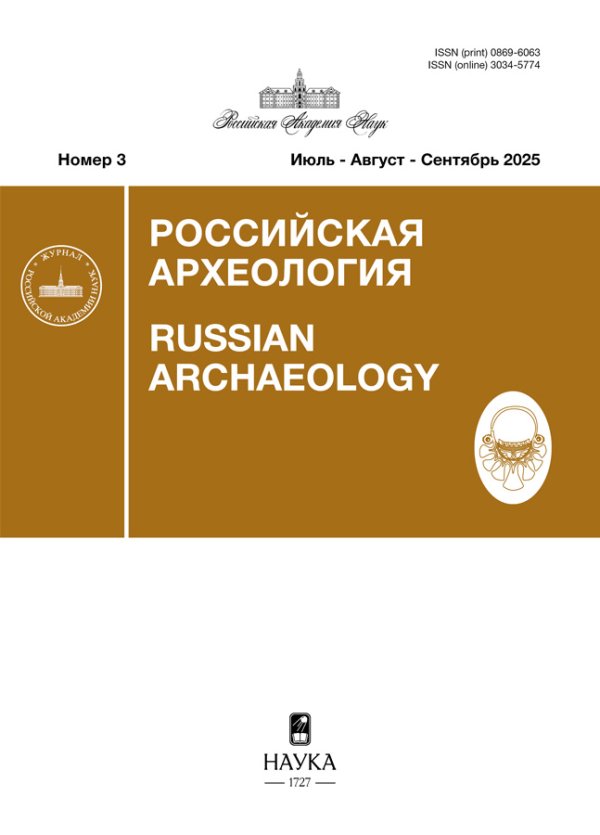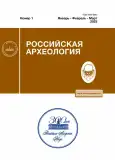КЕРАМИКА СТАНДАРТНОЙ ХАССУНЫ ПОСЕЛЕНИЯ ЯРЫМ-ТЕПЕ I ИЗ СОБРАНИЯ ГМИИ им. А.С. ПУШКИНА
- Авторы: Петрова Н.Ю.1, Колганова Г.Ю.2, Титова М.А.3
-
Учреждения:
- Институт археологии РАН
- ГМИИ им. А.С. Пушкина
- Независимый исследователь
- Выпуск: № 1 (2023)
- Страницы: 25-40
- Раздел: СТАТЬИ
- URL: https://journals.rcsi.science/0869-6063/article/view/138824
- DOI: https://doi.org/10.31857/S0869606323010154
- EDN: https://elibrary.ru/MCEKEO
- ID: 138824
Цитировать
Полный текст
Аннотация
В статье представлен обзор распространения неолитической керамики периода Стандартной Хассуны в Верхней Месопотамии от предгорий Тавра на севере примерно до района р. Дияла на юге; от предгорий Загроса на востоке до р. Балих, а возможно, и р. Евфрат на западе. Керамика Стандартной Хассуны (или влияние этой керамической традиции) фиксируется также во внутренних районах Загроса. По материалам поселения Ярым-тепе I из собрания ГМИИ им. А.С. Пушкина были изучены технологические особенности керамики Стандартной Хассуны. Они демонстрируют связь с технологией изготовления керамики предшествовавших периодов хассунской культуры – Протохассуны и Архаической Хассуны: присутствие в формовочной массе части изделий органической растительной примеси (навоза), использование при конструировании сосудов двухслойного лоскутного налепа. Новым является использование светлого ангоба, а также улучшение качества обжига, связанного со значительным развитием в это время обжиговых устройств. На керамике самаррской культуры, представленной на памятнике в виде импортов, можно предположить появление пиктографических изображений.
Ключевые слова
Об авторах
Н. Ю. Петрова
Институт археологии РАН
Автор, ответственный за переписку.
Email: petrovanatalya7@mail.ru
Россия, Москва
Г. Ю. Колганова
ГМИИ им. А.С. Пушкина
Автор, ответственный за переписку.
Email: kolganova_gy@mail.ru
Россия, Москва
М. А. Титова
Независимый исследователь
Автор, ответственный за переписку.
Email: malinkolie@rambler.ru
Россия, Москва
Список литературы
- Амиров Ш.Н. Сирия. Краткий археолого-исторический очерк от палеолита до начала эпохи эллинизма // Горы Кавказа и Месопотамская степь на заре бронзового века: сб. в честь 90-летия Р.М. Мунчаева / Отв. ред. Х.А. Амирханов. М.: ИА РАН, 2019. С. 423–445.
- Бадер Н.О. Разведки российской археологической экспедиции в Северной Месопотамии // Археология Кавказа и Ближнего Востока: сб. к 80-летию члена-корреспондента РАН, профессора Р.М. Мунчаева / Под ред. Н.Я. Мерперта и С.Н. Кореневского. М.: Таус, 2008. С. 309–319.
- Беляева А.М. Музей на фоне меняющейся эпохи: выставочная деятельность Государственного музея изобразительных искусств имени А.С. Пушкина за 100 лет. Т. 2. М.: Индрик, 2021. 672 с.
- Бобринский А.А. Гончарство Восточной Европы. Источники и методы изучения. М.: Наука, 1978. 272 с.
- Васильева И.Н., Салугина Н.П. Лоскутный налеп // Древнее гончарство. Итоги и перспективы изучения. М.: ИА РАН, 2010. С. 72–87.
- Мерперт Н.Я., Мунчаев Р.М. Раннеземледельческие поселения Северной Месопотамии (по материалам раскопок Советской экспедиции) // Российская археология. 1971. № 3. С. 141–169.
- Мунчаев Р.М., Мерперт Н.Я. Раннеземледельческие поселения Северной Месопотамии. М.: Наука, 1981. 320 с.
- Петрова Н.Ю. Технологическое изучение керамики поселения Ярым-тепе I (периоды Протохассуны и Архаической Хассуны) // Краткие сообщения Института археологии. 2016. Вып. 242. С. 48–59.
- Петрова Н.Ю. Развитие технологии изготовления неолитической керамики в Восточной Джезире и горах Загроса (Северный Ирак и Западный Иран) // Краткие сообщения Института археологии. 2019. Вып. 256. С. 329–343.
- Петрова Н.Ю. Классическая самаррская расписная неолитическая керамика (по материалам поселения Ярым-тепе I в Северном Ираке) // Археология, этнография и антропология Евразии. 2022. Т. 50. № 3. С. 29–38.
- Цетлин Ю.Б. Гончарный горн на памятнике Телль Хазна I // Мунчаев Р.М., Мерперт Н.Я., Амиров Ш.Н. Телль Хазна I. Культово-административный центр VI–III тыс. до н.э. в Северо-восточной Сирии. М.: ИА РАН, 2004. С. 404–424.
- Balossi Restelli F., Mori L. Bread, baking moulds and related cooking techniques in the Ancient Near East // Food & History. 2014. Vol. 12, iss. 3. P. 39–56.
- Braidwood R.J. Seeking the world’s first farmers in Persian Kurdistan: a full-scale investigation of Prehistoric sites near Kermanshah // Illustrated London News. 1960. № 237 (6325). P. 695–697.
- Braidwood R.J., Howe B. Prehistoric investigations in Iraqi Kurdistan. Chicago: The University of Chicago Press, 1960. 246 p.
- Breniquet C. Tell Es-Sawwan. Realites et problemes // Iraq. 1991. № LIII. P. 75–90.
- Breniquet C. Rapport sur deux campagnes de fouilles a Tell Es-Sawwan, 1988–1989 // Mesopotamia. 1992. № 27. P. 5–30.
- Caldwell J.R. The pottery from the soundings at Gird Ali Agha // Prehistoric archaeology along the Zagros Flanks / Ed. L.S. Braidwood et al. Chicago: The Oriental Institute of the University of Chicago, 1983 (Oriental Institute Publications; 5). P. 649–660.
- Caneva I. Til Huzur – Yayvantepe // The Neolithic in Turkey. Vol. 1 / Eds. M. Özdoğan, N. Başgelen. Istanbul: Archaeology and Art Publications, 2011. P. 173–184.
- Cruells W. The Proto-Halaf: Origins, definition, regional framework and chronology // Proceedings of the 5th International Congress on the Archaeology of the Ancient Near East. Madrid, 2008. P. 671–689.
- Gut R.V. Das prähistorische Ninive: zur relativen Chronologie der frühen Perioden Nordmesopotamiens. Mainz am Rhein: P. von Zabern, 1995 (Baghdader Forschungen; 19). 355 + 143 S.
- Herzfeld E. Die vorgeschichtlichen töpfereien von Samarra. Berlin: Dietrich reimer (Ernst Vohsen), 1930. 107 S.
- Hole F. Interactions between Western Iran and Mesopotamia. From the 9th–4th Millennia B.C. // Iranian Journals of archaeological studies. 2011. № 1. P. 1–14.
- Ii H., Kawamata M. The excavations at Tell Jigān by the Japanese archaeological expedition: a preliminary report on the first season of work // Al-Rāfidān. 1985. № V–VI (1984–1985). P. 151–214. (In Japanese).
- Kodaş E., Sağlamtimur H., Erdal Y.S. Three Human Graves of the Hassuna Culture in Türbe Höyük // Anatolia Antiqua. 2018. № XXVI. P. 13–22.
- Kopanias K., Beuger C., Carter T., Fox Sh., Hadjikoumis A., Kourtessi-Philippakis, Livarda A., Magginnis J. The tell Nader and tell Baqrta project in the Kurdish region of Iraq. Preliminary report of the 2011 season // SU-BARTY. Archaeological Journal of the Kurdish Region of Iraq. 2012. P. 1–31.
- Larsa (10eme campagne, 1983) et Oueili (4eme campagne, 1983): rapport preliminaire / Ed. J.L. Huot. Paris: Editions Recherche sur les Civilizations, 1987. 267 p.
- Le Mière M. The Neolithic pottery from Tell Kosak Shamali // Tell Kosak Shamali. The archeological investigations on the Upper Euphrates, Syria. Vol. II. Tokyo, 2001. P. 179–211.
- Le Mière M., Nieuwenhuyse O. The prehistoric pottery // Tell Sabi Abyad. The Late Neolithic settlement. Istanbul: Nederlands historisch-archaeologisch instituut, 1996. P. 119–284.
- Lebeau M. Apercu de la ceramique de la phase Oueili (Obeid 0) // Larsa (10eme campagne, 1983) et 'Oueili (4eme campagne, 1983): rapport preliminaire / Ed. J.L. Huot. Paris: Editions Recherche sur les Civilizations, 1987. P. 95–120.
- Levine L.D., McDonald M.A. The Neolithic and Chalcolithic periods in the Mahidasht // IRAN. Journal of the British Institute of Persian studies. 1977. № XV. P. 39–51.
- Lloyd S. Some ancient sites in the Jebel Sinjar district // Iraq. 1938. № 5. P. 123–142.
- Lloyd S., Safar F. Tell Hassuna: Excavations by the Iraq Government Directorate of Antiquities in 1943–44 // Journal of Near Eastern Studies. 1945. № 4. P. 255–331.
- Merpert N.Ya., Munchaev R.M. Early agricultural settlements in the Sinjar plain, Northern Iraq // Iraq. 1973. № 35 (Autumn). P. 93–113.
- Merpert N., Munchaev R. Yarim Tepe I // Early stages in the evolution of Mesopotamian civilization. Soviet excavations in Northern Iraq. Arizona: The University of Arizona Press, 1993. P. 73–114.
- Mortensen P. Tell Shimshara. The Hassuna period. Copenhagen, 1970 (Det Kongelige Danske Videnskabernes Selskab Historisk-Filosofiske Skrifter; 5, 2). 148 p.
- Nieuwenhuyse O. Tell Baghouz reconsidered: a collection of “Classic” Sammaran sherds from the Louvre // Syria. 1999. № 76. P. 1–18.
- Nieuwenhuyse O., Jacobs L., Van As B. The ceramics // Tell Boueid II. A late Neolithic village on the Middle Khabur (Syria) / Eds. A. Syleiman, O. Nieuwenhuyse. Turnhout: Brepols, 2002 (Subartu; XI). P. 35–124.
- Niknami K.-A., Nikzad M. New evidence of the Neolithic period in West Central Zagros: the Sarfirouzabad-Mahidasht Region, Iran // Documenta Praehistorica, 2012. № XXXIX. P. 453–458.
- Odaka T. Samarra pottery in the National Museum of Aleppo, Syria // Al-Rāfidān. 2003. № XXIV. P. 25–35.
- Odaka T. Neolithic potsherds from Matarrah, Northern Iraq: the collection of the University Museum, the University of Tokyo // Decades in Deserts: Essays on Near Eastern Archaeology in honour of Sumio Fujii. Tokyo, 2019. P. 251–260.
- Odaka T. Neolithic potsherds from Tell Hassuna: the collections of the University Museum, the University of Tokyo // Neolithic pottery from the Near East. Production, distribution and use / Eds. R. Özbal, M. Er-dalkiran, Y. Tonoike. Istanbul, 2021 (Koç University press; 259). P. 169–182.
- Odaka T., Nieuwenhuyse O., Mühl S. From the 7th to the 6th millennium BC in Iraqi Kurdistan: A local ceramic horizon in the Shahrizor Plain // Paléorient, 2019. № 45/2. P. 67–83.
- Ökse A.T. New data on the late Neolithic pottery from the Northern Upper Tigris region: the Ambar dam reservoir // Neolithic pottery from the Near East. Production, distribution and use / Eds. R. Özbal, M. Erdalkiran, Y. Tonoike. Istanbul, 2021 (Koç University press; 259). P. 307–322.
- Oueili: travaux de 1985. Paris: Editions Recherche sur les Civilizations, 1991. 270 p.
- Petrova N. Neolithic pottery technology of Sinjar Valley, Northern Iraq (Proto-Hassuna and Archaic Hassuna periods) // Neolithic pottery from the Near East. Production, distribution and use / Eds. R. Özbal, M. Er-dalkiran, Y. Tonoike. Istanbul, 2021 (Koç University press; 259). P. 213–228.
- Shepard A.O. Ceramics for the Archaeologist. Washington: Carnegie institution of Washington, 1985. 414 p.
- Suleiman A., Nieuwenhuyse O. A note on the Hassuna/Samarra site of tell Boueid II // Neo-Lithics. A Newsletter of Southwest Asian Lithics Research. 1999. Vol. 1. P. 1–2.
- Taranto S., Forte V., Gómez Bach A., Lemorini C., Molist M. A first assessment of technological and functional traces on Late Neolithic Husking trays from the Near East // Neolithic pottery from the Near East. Production, distribution and use / Eds. R. Özbal, M. Erdalkiran, Y. Tonoike. Istanbul, 2021 (Koç University press; 259). P. 229–238.
- Tekin H. Hakemi Use: a newly established site dating to the Hassuna/Samarra period in Southeastern Anatolia // Proceeding of the 5 International Congress on the Archaeology of the Ancient Near East. Madrid: Centro Superior de Estudios sobre el Oriente Proximo y Egipto, 2008. P. 271–283.
- Tekin H. Hakemi Use: a newly discovered Late Neolithic site in Southeastern Anatolia // The Neolithic in Turkey. Istanbul: Archaeology & Art Publication, 2011. P. 151–172.
- Tsuneki A., Rasheed K., Saber S.A., Nishiyama Sh., An-ma R., Ismail B.B., Hasegawa A., Tatsumi Y., Miyauchi Y., Makino M., Kudo Y. Excavations at Qalat Said Ahmadan, Slemani, Iraq-Kurdistan: first interim report (2014 season) // Al-Rāfidān, 2015. № XXXVI. P. 1–63.
- Voigt M.M. Hajji Firuz Tepe, Iran: The Neolithic settlement. Philadelphia: University of Pennsylvania, 1983. 525 p.
- Yutsis-Akimova S., Gallet Y., Petrova N., Nowak S., Le Goff M. Geomagnetic field in the Near East at the beginning of the 6th millennium BC: Evidence for alternating weak and strong intensity variations // Physics of Earth and Planetary Interiors. 2018. № 282. P. 49–59.
Дополнительные файлы


















